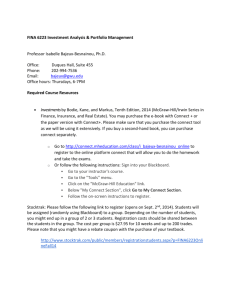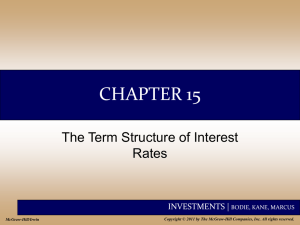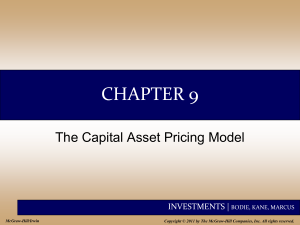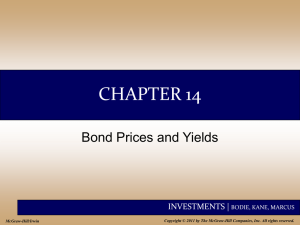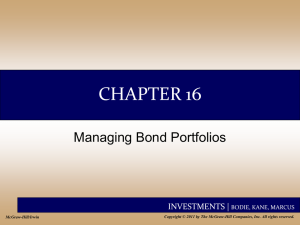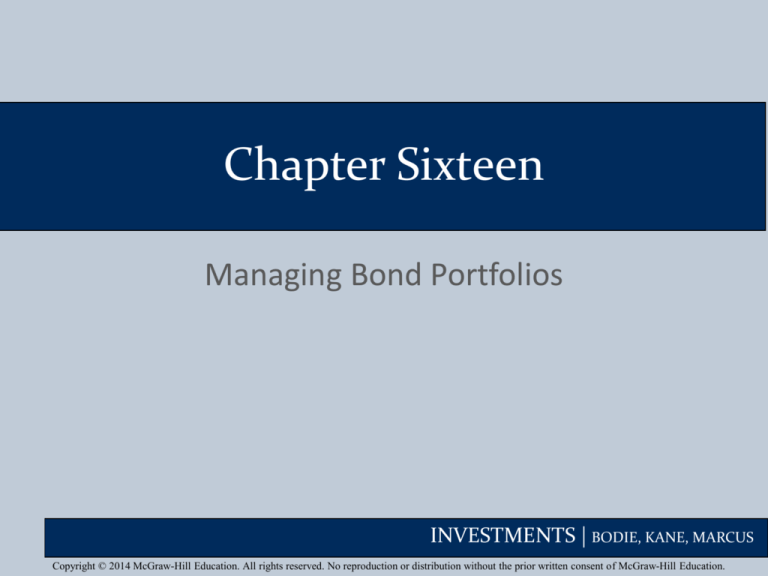
Chapter Sixteen
Managing Bond Portfolios
INVESTMENTS | BODIE, KANE, MARCUS
Copyright © 2014 McGraw-Hill Education. All rights reserved. No reproduction or distribution without the prior written consent of McGraw-Hill Education.
Chapter Overview
• Interest rate risk
• Interest rate sensitivity of bond prices
• Duration and its determinants
• Convexity
• Passive and active management strategies
16-2
INVESTMENTS | BODIE, KANE, MARCUS
Interest Rate Risk
• Interest Rate Sensitivity
1. Bond prices and yields are inversely related
2. An increase in a bond’s yield to maturity results
in a smaller price change than a decrease of
equal magnitude
3. Long-term bonds tend to be more price sensitive
than short-term bonds
16-3
INVESTMENTS | BODIE, KANE, MARCUS
Interest Rate Risk
• Interest Rate Sensitivity
4. As maturity increases, price sensitivity increases
at a decreasing rate
5. Interest rate risk is inversely related to the
bond’s coupon rate
6. Price sensitivity is inversely related to the yield to
maturity at which the bond is selling
16-4
INVESTMENTS | BODIE, KANE, MARCUS
Figure 16.1 Change in Bond Price as a
Function of Change in Yield to Maturity
16-5
INVESTMENTS | BODIE, KANE, MARCUS
Table 16.1 Prices of 8% Coupon Bond
(Coupons Paid Semiannually)
16-6
INVESTMENTS | BODIE, KANE, MARCUS
Table 16.2 Prices of Zero-Coupon Bond
(Semiannually Compounding)
16-7
INVESTMENTS | BODIE, KANE, MARCUS
Interest Rate Risk
• Duration
• A measure of the effective maturity of a bond
• The weighted average of the times until each
payment is received, with the weights
proportional to the present value of the payment
• It is shorter than maturity for all bonds, and is
equal to maturity for zero coupon bonds
16-8
INVESTMENTS | BODIE, KANE, MARCUS
Interest Rate Risk
• Duration calculation:
wt
1 y
CFt
t
Price
T
D t wt
t 1
• CFt = Cash flow at time t
16-9
INVESTMENTS | BODIE, KANE, MARCUS
Interest Rate Risk
• Duration-Price Relationship
• Price change is proportional to duration and not
to maturity
1 y
P
D
P
1 y
• D* = Modified duration
P
D * y
P
16-10
INVESTMENTS | BODIE, KANE, MARCUS
Example 16.1 Duration and
Interest Rate Risk
• Two bonds have duration of 1.8852 years
• One is a 2-year, 8% coupon bond with YTM=10%
• The other bond is a zero coupon bond with
maturity of 1.8852 years
• Duration of both bonds is 1.8852 x 2 = 3.7704
semiannual periods
• Modified D = 3.7704/1 + 0.05 = 3.591 periods
16-11
INVESTMENTS | BODIE, KANE, MARCUS
Example 16.1 Duration and
Interest Rate Risk
• Suppose the semiannual interest rate
increases by 0.01%. Bond prices fall by
P
D * y
P
= -3.591 x 0.01%
= -0.03591%
• Bonds with equal D have the same interest
rate sensitivity
16-12
INVESTMENTS | BODIE, KANE, MARCUS
Example 16.1 Duration and
Interest Rate Risk
16-13
Coupon Bond
Zero
• The coupon bond, which
initially sells at $964.540,
falls to $964.1942, when
its yield increases to
5.01%
• Percentage decline of
0.0359%
• The zero-coupon bond
initially sells for
$1,000/1.053.7704 =
$831.9704
• At the higher yield, it sells
for $1,000/1.053.7704 =
$831.6717, therefore its
price also falls by 0.0359%
INVESTMENTS | BODIE, KANE, MARCUS
Interest Rate Risk
• What Determines Duration?
• Rule 1
• The duration of a zero-coupon bond equals its time to
maturity
• Rule 2
• Holding maturity constant, a bond’s duration is higher
when the coupon rate is lower
• Rule 3
• Holding the coupon rate constant, a bond’s duration
generally increases with its time to maturity
16-14
INVESTMENTS | BODIE, KANE, MARCUS
Interest Rate Risk
• What Determines Duration?
• Rule 4
• Holding other factors constant, the duration of a
coupon bond is higher when the bond’s yield to
maturity is lower
• Rules 5
• The duration of a level perpetuity is equal to:
(1 + y) / y
16-15
INVESTMENTS | BODIE, KANE, MARCUS
Figure 16.2 Bond Duration versus
Bond Maturity
16-16
INVESTMENTS | BODIE, KANE, MARCUS
Table 16.3 Bond Durations (Yield to
Maturity = 8% APR; Semiannual Coupons)
16-17
INVESTMENTS | BODIE, KANE, MARCUS
Convexity
• The relationship between bond prices and
yields is not linear
• Duration rule is a good approximation for only
small changes in bond yields
• Bonds with greater convexity have more
curvature in the price-yield relationship
16-18
INVESTMENTS | BODIE, KANE, MARCUS
Figure 16.3 Bond Price Convexity: 30-Year
Maturity, 8% Coupon; Initial YTM = 8%
16-19
INVESTMENTS | BODIE, KANE, MARCUS
Convexity
1
Convexity
2
P (1 y )
CFt
2
(1 y )t (t t )
t 1
n
• Correction for Convexity:
P
2
1
D y [Convexity (y ) ]
2
P
16-20
INVESTMENTS | BODIE, KANE, MARCUS
Figure 16.4 Convexity of Two Bonds
16-21
INVESTMENTS | BODIE, KANE, MARCUS
Why Do Investors Like Convexity?
• Bonds with greater curvature gain more in
price when yields fall than they lose when
yields rise
• The more volatile interest rates, the more
attractive this asymmetry
• Bonds with greater convexity tend to have
higher prices and/or lower yields, all else
equal
16-22
INVESTMENTS | BODIE, KANE, MARCUS
Duration and Convexity
• Callable Bonds
• As rates fall, there is a ceiling on the bond’s
market price, which cannot rise above the call
price
• Negative convexity
• Use effective duration:
P P
Effective Duration
r
16-23
INVESTMENTS | BODIE, KANE, MARCUS
Figure 16.5 Price –Yield Curve for
a Callable Bond
16-24
INVESTMENTS | BODIE, KANE, MARCUS
Duration and Convexity
• Mortgage-Backed Securities (MBS)
• The number of outstanding callable corporate
bonds has declined, but the MBS market has
grown rapidly
• MBS are based on a portfolio of callable
amortizing loans
• Homeowners have the right to repay their loans at
any time
• MBS have negative convexity
16-25
INVESTMENTS | BODIE, KANE, MARCUS
Duration and Convexity
• Mortgage-Backed Securities (MBS)
• Often sell for more than their principal balance
• Homeowners do not refinance as soon as rates
drop, so implicit call price is not a firm ceiling on
MBS value
• Tranches – the underlying mortgage pool is
divided into a set of derivative securities
16-26
INVESTMENTS | BODIE, KANE, MARCUS
Figure 16.6 Price-Yield Curve for
a Mortgage-Backed Security
16-27
INVESTMENTS | BODIE, KANE, MARCUS
Figure 16.7 Cash Flows to Whole Mortgage
Pool; Cash Flows to Three Tranches
16-28
INVESTMENTS | BODIE, KANE, MARCUS
Passive Management
• Two passive bond portfolio strategies:
• Indexing
• Immunization
• Both strategies see market prices as being
correct, but the strategies are very different in
terms of risk
16-29
INVESTMENTS | BODIE, KANE, MARCUS
Passive Management
• Bond Index Funds
• Bond indexes contain thousands of issues, many
of which are infrequently traded
• Bond indexes turn over more than stock indexes
as the bonds mature
• Therefore, bond index funds hold only a
representative sample of the bonds in the actual
index
16-30
INVESTMENTS | BODIE, KANE, MARCUS
Figure 16.8 Stratification of
Bonds into Cells
16-31
INVESTMENTS | BODIE, KANE, MARCUS
Passive Management
• Immunization
• A way to control interest rate risk that is widely
used by pension funds, insurance companies, and
banks
• In a portfolio, the interest rate exposure of assets
and liabilities are matched
• Match the duration of the assets and liabilities
• Price risk and reinvestment rate risk exactly cancel
out
• As a result, value of assets will track the value of
liabilities whether rates rise or fall
16-32
INVESTMENTS | BODIE, KANE, MARCUS
Table 16.4 Terminal value of a
Bond Portfolio After 5 Years
16-33
INVESTMENTS | BODIE, KANE, MARCUS
Figure 16.9 Growth of Invested Funds
16-34
INVESTMENTS | BODIE, KANE, MARCUS
Table 16.5 Market Value Balance Sheet
16-35
INVESTMENTS | BODIE, KANE, MARCUS
Figure 16.10 Immunization
16-36
INVESTMENTS | BODIE, KANE, MARCUS
Passive Management
• Cash Flow Matching and Dedication
• Cash flow matching = Automatic immunization
• Cash flow matching is a dedication strategy
• Not widely used because of constraints associated
with bond choices
16-37
INVESTMENTS | BODIE, KANE, MARCUS
Active Management
• Swapping Strategies
1.
2.
3.
4.
5.
16-38
Substitution swap
Intermarket spread swap
Rate anticipation swap
Pure yield pickup swap
Tax swap
INVESTMENTS | BODIE, KANE, MARCUS
Active Management
• Horizon Analysis
• Select a particular holding period and predict the
yield curve at end of period
• Given a bond’s time to maturity at the end of the
holding period its yield can be read from the
predicted yield curve and the end-of-period price
can be calculated
16-39
INVESTMENTS | BODIE, KANE, MARCUS

